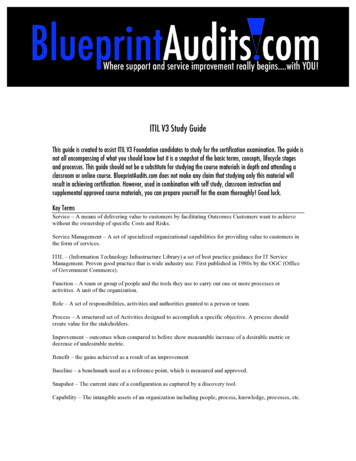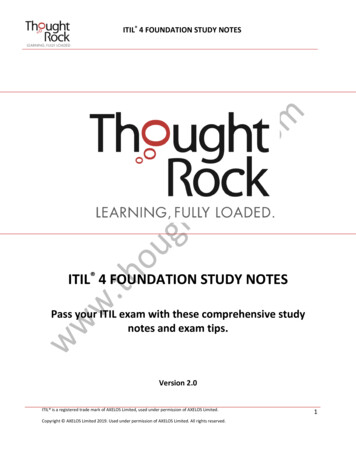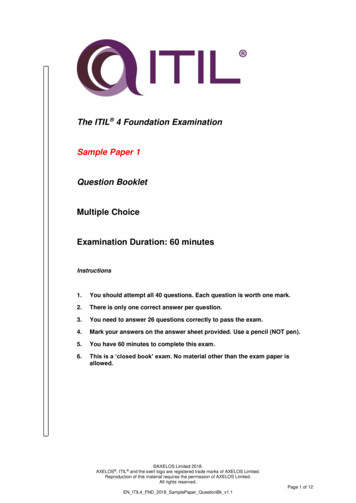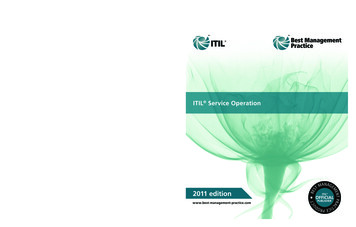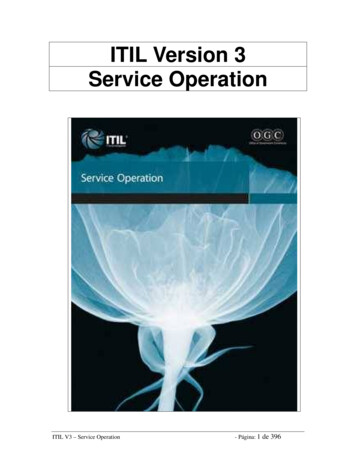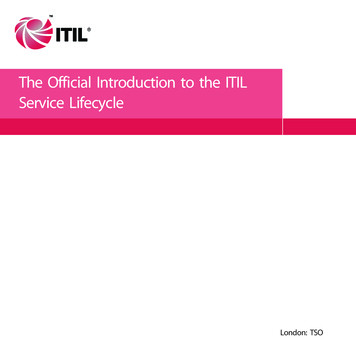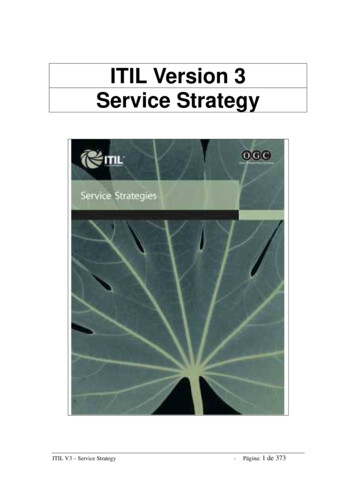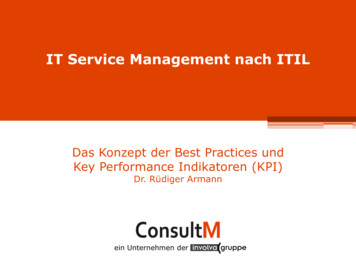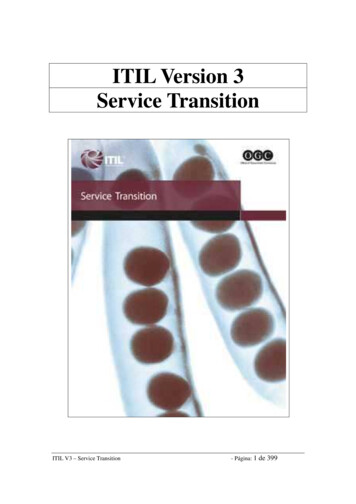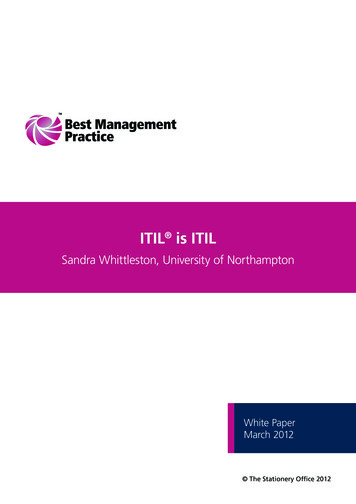
Transcription
ITIL is ITILSandra Whittleston, University of NorthamptonWhite PaperMarch 2012 The Stationery Office 2012
2ITIL is ITILContentsExecutive summaryWhat exactly is ITIL ?33Introduction31Where is the confusion?32The challenge of strategies43The real need for evolving methods53.1 What actual or tangible benefits do these points hope to achieve?54So what is ITIL and where does it currently fit?55Reflections and further discoveries66Where do we go from here?7References7Further reading7About the author8Acknowledgements8Trademarks and statements8 The Stationery Office 2012
ITIL is ITIL 3Executive summaryWhat exactly is ITIL?ITIL is a framework that has evolved to meet the issuesorganizations face. It started life in the 1980s when Her Majesty’sGovernment in the United Kingdom, which was concerned withthe quality of service it was getting from its IT, tasked the CentralComputer and Telecommunications Agency with developing aframework for the efficient and financially responsible use of ITresources. A team of experienced professionals with practicalknowledge of IT led the process of creating an IT infrastructurelibrary containing a series of 42 books grouped in specific subjectareas. The framework addressed management rather thantechnical issues although originally there was a significanttechnical aspect to it. As it matured it became clear that ITIL canand should exist above the technical aspects, producing guidancethat is not reliant on any particular technology and still deliveringvalue to the organization.When the guidance was revised in the mid-2000s, it wasrecognized that the strategy and continual service improvementaspects had been largely overlooked, or at least were not clearlyidentifiable. The concept of a cyclical approach to themanagement of IT was raised to encompass the whole of theservice management ‘lifecycle’. This shift to addressing thelifecycle was important as it is vital that services are seen in theirentirety from strategic conception to retirement and that theyare reviewed and improved throughout their life.As ITIL progressed and matured there became a requirement forindividuals to be trained and gain certification. When thequalification scheme started it was not coordinated centrally.This led to a mismatch in terms of how a significant part of thecommunity viewed ITIL. It was agreed that it would be sensibleto move towards the unification of qualifications and create asingle structure for syllabuses and exams.When the lifecycle approach was introduced in 2007, a new setof lifecycle training manuals and qualifications was introduced(V3). Both schemes (V2 and V3) ran in parallel and there was arequirement to distinguish between them. A combination of theV2/V3 qualification schemes was then used to assist in clarifyingthis position. For the next few years these schemes coexistedvery well as they allowed those who had existing V2qualifications to continue on their present scheme. However, in2011, the V2 scheme was discontinued. The lifecycle approachat the core of the material was improved but it did not gothrough a formal version revision. This means that the lifecycleunder V3 is now the only scheme in existence and the need forthe distinction has disappeared.Since its conception ITIL has matured and developed to meetthe challenges that IT service management faces. It hascontinued to do that from the mainframe days of the 1980s tothe clouds of the present day, but at its heart it is, and willalways remain, just ITIL.Phil HearsumITSM Portfolio Manager, Cabinet OfficeIntroductionThere can be no doubt that ITIL V3 has caused active debatesince its launch in 2007, especially when IT practitioners weresuddenly faced with an updated version. The V2 qualificationshad primarily concentrated on two of the publications, ServiceDelivery and Service Support, even though the full suite alsocovered, for example, improvements to service and the businessperspective. The logic behind the evolution was widelydocumented at the time that V3 was built on V2. It alsoprovided improvements and additional material via feedbackfrom those using the techniques in the field and to ensure,amongst other things, an ‘outcome-based, service valueapproach’ themed on the service lifecycle. Logically, ContinualService Improvement was now identified as one of the coretexts in V3. Feedback from practitioners is the mainstay of theevolution and the strength of the latest version comes fromoffering enhancements to well-understood processes,describing new approaches in the form of ‘living’ examples andproviding robust connections to business-orientated techniquessuch as knowledge management.This white paper will explore the core philosophy of ITIL, todemonstrate that it is a dynamic and structured frameworkwhich is meant to have an effect on, and engage proactivelywith, the business, and why that is. In particular it will try tochallenge some assumptions so that readers will discover theanswers for themselves; it is hoped they will move on fromthinking purely in versions and understand why they are nolonger important.1Where is the confusion?There is a multitude of practitioner-led papers on implementingITIL. Some are written such that they appear to be versiondependent; others not. Key themes emerge, evidenced by thenumber of IT service management support organizationsproducing white papers and guides. Many describe thoseprocesses which might be important in a common set ofcircumstances. Historically they have focused on servicecatalogue, service level agreements, service desk, changemanagement and configuration management. These werealways important in V2 and well understood by IT servicemanagement practitioners. It is essential to understand thatthey are still core to V3. Latterly, papers have emerged onknowledge management, service portfolio management andservice transition, which are new and topical in V3. From apractical perspective, whilst these topics are newly acquiredand described in ITIL V3, their roots are from a variety ofsources going back over many generations and have theirorigins elsewhere.So where is the evidence for their inclusion? In order toanswer this question it is important to explore the vexed issueof organizational dynamics and the role that informationsystems play. The Stationery Office 2012
4ITIL is ITILOrganizations are dynamic in nature and supported by a rangeof systems and subsystems. The importance of the role ofinformation systems and technology for modern businesses isundisputed. Their development within an organization is akin toa subset of organizational dynamics with particular themesrelevant to them.High-quality (academic) research into the social theoriessurrounding information systems development is still aniche area. In their landmark work Social Theory andPhilosophy for Information Systems, Mingers and Willcocks(2005) explored (using various authors’ work) the combinedeffects of social, philosophical and systems approaches inorder to understand how information systems are usedand developed. Evidence supports the argument that thesocial constructs of organizations play an important part inhow the IT estate develops. Conversely, similarities can beidentified in the development of information systems andtheir effects on the organization. This is important becauseIT and business systems are evolving, dynamic organisms intheir own right, so managing them is bound to be fraughtwith inherent difficulties.Nonaka (1996) describes forms of knowledge key to ‘the onesure source of lasting competitive advantage’ for anorganization. In fact knowledge management has beenembedded in business theories and texts for many years.Research shows that the impact of new and changedtechnology solutions on an organization can be positive ornegative depending on how they are delivered. It is importantto note that change is strategic, tactical and operational and anorganizational concern. It is subject to a wide range ofinfluences such as culture, organizational dynamics, the pace ofchange, the forces for change, resistance to change, perceptionsof change, responses to change and organizational andindividual behaviours and their impact on change. With theevidence of the dynamic nature of IT and business systems it istherefore important to use transitional logic to develop both.Hence the theme of transitioning services.Having a business-supported customer self-serve portal is acommon approach to customer engagement and the portalplays its part in customer relationship management. Many ITstrategists have long seen the benefits of so-called ‘softsystems’ approaches. A classic is Senge’s work of the 1960s,updated in 2006, on creating a learning organization built onknowledge transfer. Proactive learning organizations areintrinsically knowledge-based and evidence shows thatconsidering these issues is important. Soft Systems Methods,discussed by Checkland and Scholes (1999), argue that thereare many ways to reach ‘desired’ end goals that requirenon-linear approaches. These concepts are firmly embedded inITIL philosophy and provide flexibility for IT professionals as theyoffer opportunities for them to be creative in their approachesto IT management. The Stationery Office 2012Similarly the concepts of portfolios, value chains and marketing(described in IT terminology in Service Strategy) are longstanding business development techniques taught notably onmaster of business administration courses in universities andused extensively by business executives. There can be no doubtthat they are valuable tools and methods in the debate aboutstrategic business management and are relevant also to IT.Is ITIL V3 therefore just a blend of V2 which has been updated,evolved constructively and progressed sufficiently to includeworkable scenarios and examples? Not really; it is, at its heart, alogical living framework for managing IT which works in avariety of circumstances. Anecdotal evidence suggests thatthere is confusion about its theme, direction and applicability.So how can this be unpicked and explored? What might be akey sticking point is the use of the term ‘strategy’ and it willtherefore be essential to explore it in greater detail.2The challenge of strategiesThe term ‘strategy’ has many definitions which can be appliedacross all levels of an organization from business strategy tofunctional strategy. It can be identified as the amount of detailrequired to achieve an end goal. It can also be usedeuphemistically to describe a series of business articulations toidentify the actions needed for the long-term success of anorganization. As Emily Chan (2009) identifies, business leadersnow have tools and other methods at their disposal to ‘bring asignificant degree of analytical rigor into strategy’. According toChan, these tools and methods are ‘Frameworks, DataManagement, Classic Strategies and Process’. Do these soundfamiliar? It is important to note that commonly used businessmanagement activities have always been included in ITILmaterial, particularly in the Business Perspective publication.Similarly, quality management techniques were describedextensively in Planning to Implement Service Management inthe V2 suite of products now embedded in the continual serviceimprovement process in V3.As we have seen before, organizations are dynamic entities andin his research, Mintzberg (2000) describes some fundamentalchallenges to strategic planning. These are important to notebecause, as we will see later, they have a bearing on successfulITIL implementations.To better understand how strategy is perceived, Mintzbergquotes evidence to describe the symbiotic relationship betweenplanning and forecasting and the inherent difficulties posed. Hestates that ‘planning, in the absence of an ability to control theenvironment, must rely on forecasting, and because forecastingamounts to extrapolation of known states, existing trends orrecurring patterns planning typically works best underconditions of relative stability’. To paraphrase Mintzberg, it isalso a perception of strategic planning which has to have apoint of reference whereby everything is on hold until theplanning is done. All this is relevant when considering theevolution of services within an organization. With IT’s criticality
ITIL is ITIL 5within the business, it is essential that information systemsdevelopment sits at the heart of business planning. This is, ofcourse, the ethos of ITIL V3 Service Strategy.To further support this argument, back in 2003, Ross identifiedthat ‘firms have not derived value simply by linking IT to theirbusiness processes. Rather, they have learned how to benefitfrom IT by developing a competency in creating and evolving anenterprise IT architecture’. In aligning business strategy and ITcapabilities, IT enterprise architecture has to identify andunderstand the organization’s strategic objectives. In herresearch Ross quoted the challenge faced by a businessarchitect. She stated: ‘So we started working on understandingthe business strategy, and what we discovered was that theyreally didn’t have a business strategy. What they had were a lotof promises’. So if understanding the business strategy is achallenge in itself, how can IT capabilities be developedsufficiently to respond to evolving needs and within a workabletimeframe? The evolving framework of ITIL describes wayswhich will significantly improve the success of business strategicand IT architecture planning. Ross’s research identifies thatbusiness improves its value when it capitalizes on the learningfrom different architectural approaches, culminating in aresilient modular architectural scenario.3The real need forevolving methodsITIL tells us that developing good communications andmeaningful processes and working alongside customers andend users are essential, not least to protect IT from the vagariesof often ill-described requirements.The good news is that practitioner reports are increasinglybeing comp
This white paper will explore the core philosophy of ITIL, to demonstrate that it is a dynamic and structured framework which is meant to have an effect on, and engage proactively with, the business, and why that is. In particular it will try to challenge some assumptions so that readers will discover the


